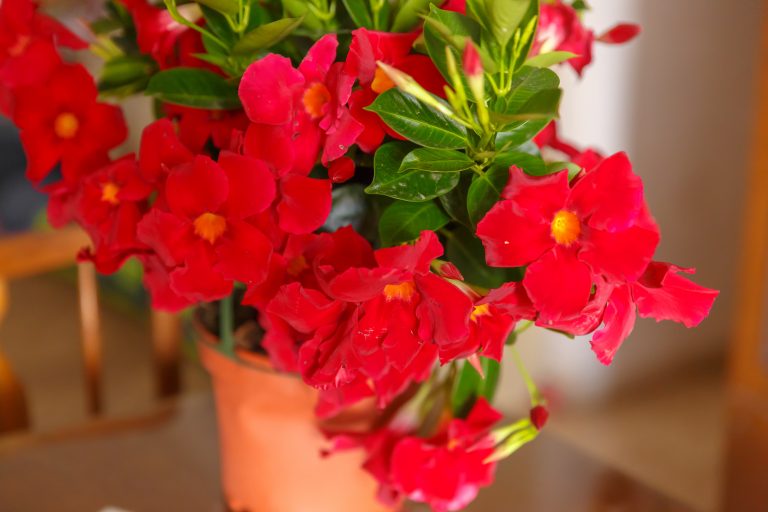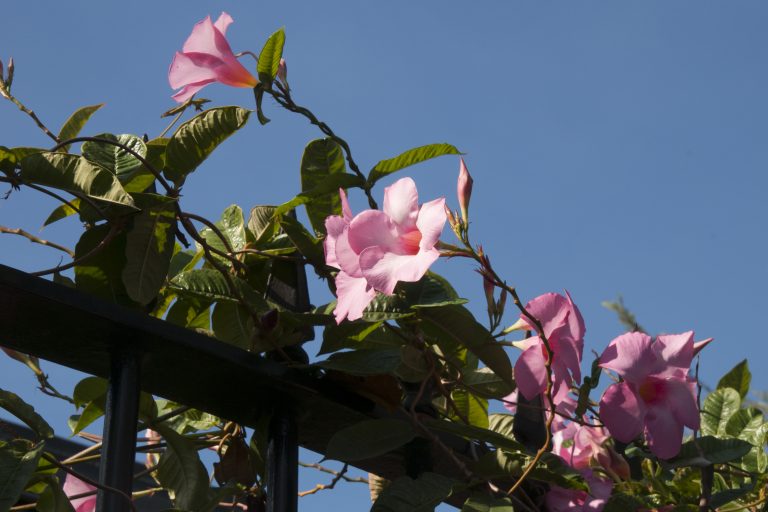If you’re keen to add a unique element to your garden or are simply looking for an easy plant to grow, the mandevilla plant should be on your list.
With a ton of colour options and climbing and non-climbing varieties available, mandevilla are diverse and divine!
The Mandevilla is a perennial plant that is easy to care for and with proper care, can flower through the season. Here’s everything you need to know!
Jump To a Section Below
- What is Mandevilla
- How to Grow Mandevilla
- How to Care for Mandevilla
- How to Propagate Mandevilla
- How to Overwinter Mandevilla
- Mounding Mandevilla
- Do Mandevilla come back every year?
- Can Mandevilla survive winter?
- Can Mandevilla take full sun?
- Do all Mandevilla plants climb?
- Can Mandevilla grow in pots?
- Do you deadhead Mandevilla?
- Is Mandevilla poisonous to dogs?
- Can you grow Mandevilla plants from cuttings?
- Is Epsom salt good for Mandevilla plants?
- Do hummingbirds like Mandevilla?
What is Mandevilla

The mandevilla, also known as rocktrumpet, is a tropical plant belonging to the Apocynaceae family. While they are fairly new to the gardening scene, mandevilla flowers are popular and come in a range of colours including pink, white and red.
How to Grow Mandevilla
When to Plant Mandevilla
You’ll find mandevilla vines in pots at local nurseries and garden centres. Wait for warmer weather before planting the flower outdoors, as it doesn’t like to grow in cold conditions. Look for a sunny location that offers protection from the wind and grow the plant there.
The plant prefers warmer climates where they can grow up to 6 metres tall. In colder climates, mandevilla plants will only grow to around 1.5 metres in length.
How to Plant Mandevilla
If the mandevilla plant is grown in a container or hanging basket, limit crowding by ensuring there’s only one plant per 35-centimetres. This allows for optimal growth.
The soil needs to be rich in nutrients and well-watered to ensure proper mandevilla vine growth and blooming. They’ll grow pretty fast in warm conditions, so keep an eye on the soil to ensure it doesn’t dry out. Additionally, add organic plant food and fertiliser to the soil every two weeks.
How to Care for Mandevilla

Mandevilla thrives in the heat. But careful attention needs to be paid to the soil to prevent it from drying out and inevitably killing the plant.
To protect mandevilla from the frost in autumn and winter, you can cover them with a sheet. This will help to keep the plant and soil warm.
You can “train” your plants to grow upwards using string or wire that leads to your fence, trellises, or pillars. To ensure that the plant survives the winter, cut it down before the first frost and bring it indoors.
While indoors, mandevilla care is important. The plant needs to remain slightly moist and protected from pests such as flies, aphids, scale, and other insects. Once the cold period is over, you can move them back outside.
How to Propagate Mandevilla
The mandevilla plant can be propagated using two main techniques, namely cuttings and planting seeds.
Cultivating mandevilla from seed is simple. Growth is most often achieved using fresh seeds extracted from dried out pods. It’s recommended that you soak the dandelion-like seeds in water for 12 hours before planting.
Plant the seeds in a shallow hole in well-draining soil. The soil needs to remain moist and warm during this time. They should germinate within a month.
Propagating mandevilla from cuttings is a fairly easy process too. Take cuttings during the spring for best results. When selecting a piece to cut, ensure it’s either a side shoot or tip around 7.5 centimetres long. Keep the top two leaves and remove the rest. Place the cuttings in a mix of sand and peat, placing it in a warm, humid, shady, and moist area. Once the roots have developed you can place the plant in its official spot.
How to Overwinter Mandevilla
Mandevilla care in winter is essential. Bring your mandevilla plant inside once the temperature has dropped to 15 °C. During this time, you’ll need to grow it like a house plant. The plant needs to be trimmed regularly and kept in the sunlight. Ensure the soil is moist and avoid overwatering the plant. It will not bloom during this time.
If you don’t have the space or a sunny spot to keep your mandevilla, you can bring it inside and store it in its dormant state. To encourage dormancy, drench the soil with water to rinse out any pests and then cut it down to 25 centimetres.
Keep the plant in a room where the temperature averages 15 °C and receives sunlight during the day. Water the soil enough to keep it from going dry and once the springtime comes and the plant breaks dormancy, you can move it back to its original spot and follow your regular care routine.
Mounding Mandevilla
As pretty as these plants may be, not everyone has space to grow a mandevilla vine along their wall or in their garden. This is where mounding mandevilla comes in. This type of mandevilla plant grows in such a way as to grow both vertically and horizontally, creating a rounded mound-like appearance so as to take up little space. They don’t need support as they don’t grow upwards and only reach a height of 45 centimetres.
Do Mandevilla come back every year?
Yes. Although many people consider this plant to be an annual, it’s a perennial and typically blooms in the late summer.
Can Mandevilla survive winter?
Mandevilla can survive the winter but only if it’s brought inside. It cannot withstand cold temperatures.
Can Mandevilla take full sun?
Yes, this is the ideal growing condition for mandevilla plants and will result in impressive blooming.
Do all Mandevilla plants climb?
Most mandevilla plants do climb. However, the mounded variety does not and was created to be more of a bush than a vine.
Can Mandevilla grow in pots?
Yes, the mandevilla is best grown in containers and hanging baskets.
Do you deadhead Mandevilla?
No, deadheading is not necessary for mandevilla care as the plant will continue to bloom and grow regardless.
Is Mandevilla poisonous to dogs?
Yes, the plant is poisonous if ingested.
Can you grow Mandevilla plants from cuttings?
Yes, the mandevilla plant can be propagated using cuttings.
Is Epsom salt good for Mandevilla plants?
Yes, Epsom salts can increase the magnesium content in the soil to promote flowering. If your plant is battling to bloom, dissolve 5mg of Epsom salts in water. Then, water your plant every second week.
Do hummingbirds like Mandevilla?
Yes, the beautiful blossoms attract hummingbirds as well as butterflies.

Lily’s love for flowers and plants was nurtured in her grandmother’s vibrant garden. Over the years, this affection blossomed into a full-fledged passion for horticulture.
With formal training in botany and countless hours in her own backyard oasis, Lily has cultivated a deep understanding of plant care and garden design.